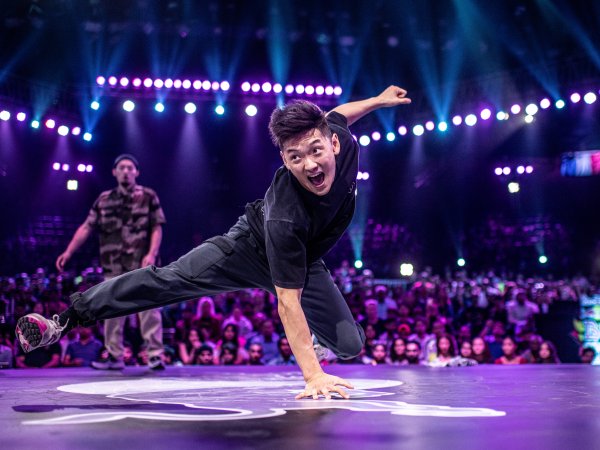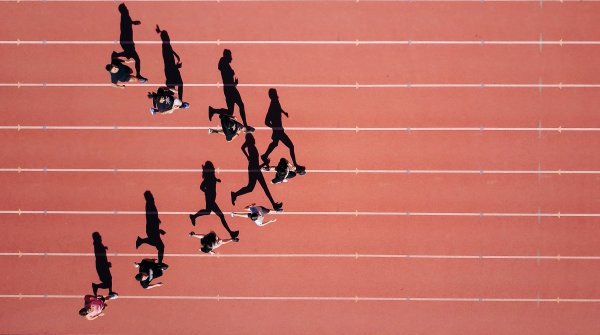- Breakdancing - From the Bronx to the World Stage at the Paris Olympics
- What does the breakdance scene think of the Olympics premiere?
- How will the breakdancing competitions at the 2024 Olympics work?
- When and where will the breakdancing competitions take place at the 2024 Olympics?
- Who are the stars of the breakdance scene before the Olympics?
- The most important questions at a glance
The Paris Olympics of 2024 has been one of the most anticipated and controversial global events in recent times, and it’s been a roller coaster so far. Considering the fact that Snoop Dogg was one of the torchbearers, there is no better fitting time for breakdancing to make its Olympics debut. At the 2024 Games, breakdancing will achieve what no other dance sport has managed before: B-boys and B-girls will break for Olympic medals for the very first time. This is the next major milestone for a sport that has its origins in the Bronx, and you can’t argue that breakdancing at the Olympics has a nice ring to it! It has been a decades-long battle in the making for breakers to get to the main stage, and their moment in the limelight has finally arrived.
Before breakdancing made it to the stage of the Olympics, it had much more humble beginnings. The urban dance style that is now widely known as breakdancing traces its roots all the way back to the 1970s in the famous neighbourhood of the Bronx. The sparks of breakdancing took flame during lively late night block parties. Against the backdrop of DJ and the New York nightlife, the stylised footwork and acrobatic movements became an integral part of the African American culture. By the 1980s, breakdancing was gaining popularity thanks to well-known groups like the New York City Breakers and the Rock Steady Crew. The first international competitions were held during the 1990s, carrying breakdancing on an upward trend that would lead to it making its Olympics debut nearly 3 decades later.
It's important to known that B-boys and B-girls have always been pioneers, and this has been a cornerstone of breakdancing that eventually led to its Olympics debut. Back in the 70s when African-American youngsters in the Bronx created breakdancing, they were pioneers who were whirling a completely new dance style onto the asphalt of the streets. And today, they will also be pioneers in Paris in 2024, representing the first time breakdancing has been displayed on a world Olympics stage. Breakdancing will then be the first dance sport ever to compete at the Olympic Games, which adds even more weight to this momentous achievement. The decision to include breakdancing in the Olympics came as an unusual move by the International Olympic Committee (IOC). Traditionally, it relies primarily on existing and established club structures to narrow down its list of approved sports. Breakdancing on the other hand, is different from these traditional Olympic standards, since it is not dominated by clubs, but rather by unofficial groups that come together to breakdance.
The first time breakdancing was given attention in the Olympics was back in 2018 during the Summer Youth Olympic Games. This single introduction was massively successful, so much so that it made its way onto the list of official sports in the 2024 Olympics. A dress rehearsal for the Olympic premiere took place in 2018 in Buenos Aires, and this is where the sport was included in the program for the first time. In a groundbreaking stunt, the breakdancing event topped over a million viewers, with the Olympics declaring it an “outstanding success.” This outperformed many of the audiences of other sports already, showing just how much magic breakdancing could bring to the Olympics. Breakdancing competitions were also held at the 2019 Southeast Asian Games in the Philippines, paving the way towards the Olympics in August everyone is eagerly awaiting.
The growing anticipation to see breakdancing at the Olympics can be felt all over the world. "In my opinion, it's great. People who previously only danced underground can now prove themselves," says Marco Greawert, founder of the Street Beatz crew. In lieu of this sport’s growing popularity, breakdancing schools and centres have been popping up all over the USA for one, and it’s hugely due to the impact that breakdancing finally being on the Olympics stage has on young break dancers, all ready to learn and hone the craft. Touching on the role that USA plays in breakdancing, some commentary: “Now, the USA is a front-runner at the Olympics,” Tyquan Hodac, USA Dance’s breaking communications director, told NBC Olympics. “We’re the powerhouse. Every other country is looking up to us.”
But among breakers, the opinions are not unanimous. Breakdancing being on the rise to an Olympic sport is also causing reservations. "Breaking is not just a well-organized sporting event, but a lifestyle full of spontaneity and creativity," says Thorsten Süfke, President of the Berlin Dance Sport Association. "You have to combine the lifestyle culture of breaking with the requirements of organized sport - that's a big balancing act." It seems that some breaking enthusiasts think the spontaneous nature of breakdancing contradicts with what is needed to become an Olympics discipline.
B-Boy and Street Beatz member Carl Ferdinand Beccard, for example, fears: "At the Olympics, there will probably be something like a list and the jury will check off everything that has to be fulfilled - that takes the creativity out of it." This puts a delicate spin on things, and whether the best break dancers in the world will be able to juggle the immense creativity of breakdancing with the rigid aspects of the Olympics remains to be seen. One thing is for sure, the whole world is holding its breath! On the other hand, many global partners like Toyota, Bridgestone and Coca Cola have teamed up to make the breakdancing debut at the Olympics as impressive as possible. The World Dance Sport Federation is now recognised as the international governing body by the IOC, signalling a long future for breakdancing in the Olympics.
The breakdancing competition at the 2024 Olympics will follow the strategy of most dance competitions. There will be two events in total, a female and a male option. There are two medal rounds in total as well - one for the men and one for the women. In a series of spectacular and stunning solo battles, 10 B-boys and 10 B-girls will compete in one-on-one duels. During a battle, the two participants take turns in so-called throw downs, each lasting 60 seconds. During this time, the dancers have the opportunity to impress the judges with their moves. Whether these power moves will include the 6-step, windmills or cool freezes, the audience is sure to be impressed. Breakdancing at the Olympics will rely heavily on adapting your style and improvising to the beat to impress the judges, and it’s expected to be a tough fight for the first breakdancing Olympic medals ever!
After the breakdancing battle, the Olympics jury of judges then awards a score based on six criteria: creativity, personality, technique, versatility, performance skills and musicality. Technique, performance and creativity make up 60% of the overall score, with the other three criteria accounting for 40%. Of course, whoever achieves the highest score wins and moves on to the next round of the Olympics breakdancing competition. The addition of new sports like breakdancing to the Olympics Roster is an attempt by the IOC to appeal to the younger generations, and breakdancing now joins the Olympics alongside surfing, skateboarding and sport climbing who made the list during the Tokyo Olympics. “All four are easy to take up and participants form communities that are very active on social media,” according to the Paris Olympics.
An action-packed breakdancing weekend awaits the audience in Paris – with impressive moves and thrilling performances guaranteed to make a splash at the Olympics.
On August 9, the breakdance battles will take place in the women's categories, with the qualifying round from 4 to 6 pm and the final from 8 to 10 pm. On the following Saturday, August 10, the men’s battle for the coveted title in their qualifying rounds takes place from 4 to 6 p.m., and the final from 8 to 10 p.m. Be sure to not miss this historical Olympics moment for breakdancing!
In the men's Olympics, three-time world champion Phil Wizard from Canada and Japanese breakdance star Shigekix are the top favourites in the breakdancing world. Shigekix has achieved third place at the 2018 Youth Olympic Games in Buenos Aires, making him a leading candidate. Other well-known names in the breakdancing scene are French B-Boy Danny and B-Boy Amir from Kazakhstan, who have significantly contributed to getting this sport to the Olympics.
Among the women, we have the US American Logistx and the Japanese B-Girl Ami, who won the 2022 World Championships. Another breakdancing legend is B-Girl Ayumi, who continues to perform at the highest level at the age of 39. Other stars of the breaking scene include B-Girl India from the Netherlands, who won the 2022 European Championships, as well as B-Girl 671 from China and B-Girl MadMax from Belgium.
There are two breakers from the USA who have qualified for the Paris games, B-girl Sunny Choi and B-boy Victor Montalvo. 10 B-boys and 10 B-girls have qualified out of a group of 80 breakdancing professionals who battled it out for a spot at the Olympics. “This is a chance for us to grow and educate people on breaking,” B-boy Jeffrey Louis shared with the NBC Olympics. He is ranked fifth in the world in breakdancing and believes the following about the Olympics: “If we get it right, we can create something unstoppable.”
Everything you need to know about breakdancing at the Olympics:
How does the breakdance scene perceive its debut at the Olympics?
Opinions vary. Some are excited for the recognition breakdancing will receive, while others fear the Olympics may affect the spontaneity and creativity of the art form.
How do breakdancing competitions unfold at the 2024 Olympics?
There are breakdancing solo battles with B-Boys and B-Girls, each in one-on-one duels. Olympics judges evaluate creativity, technique, and more.
- When and where will the breakdancing competitions at the 2024 Olympics take place?
In the breakdancing Olympics, Women compete on August 9th, men on August 10th in Paris, with qualifying rounds and finals in the evening.
Who are the stars of the breakdancing scene ahead of the Olympics?
Top favourites among men include Phil Wizard and Shigekix, while among women, it's Logistx, B-Girl Ami, and B-Girl Ayumi.
How many new sports were added to the 2024 Olympics?
Breakdancing is the newest sport to join the Olympics, joining surfing, skateboarding and sport climbing that were added at the 2024 Olympic Games.

 Sports BusinessSki Mountaineering Goes Olympic: What Milano-Cortina 2026 Means
Sports BusinessSki Mountaineering Goes Olympic: What Milano-Cortina 2026 Means
- ISPO awards
- Mountain sports
- Bike
- Design
- Retail
- Fitness
- Health
- ISPO Job Market
- ISPO Munich
- ISPO Shanghai
- Running
- Brands
- Sustainability
- Olympia
- OutDoor
- Promotion
- Sports Business
- ISPO Textrends
- Triathlon
- Water sports
- Winter sports
- eSports
- SportsTech
- OutDoor by ISPO
- Heroes
- Transformation
- Sport Fashion
- Urban Culture
- Challenges of a CEO
- Trade fairs
- Sports
- Find the Balance
- Product reviews
- Newsletter Exclusive Area
- Magazine






